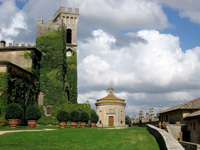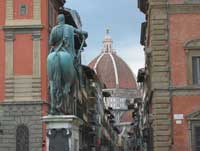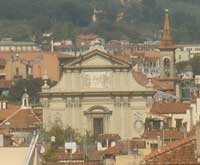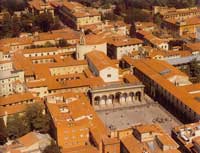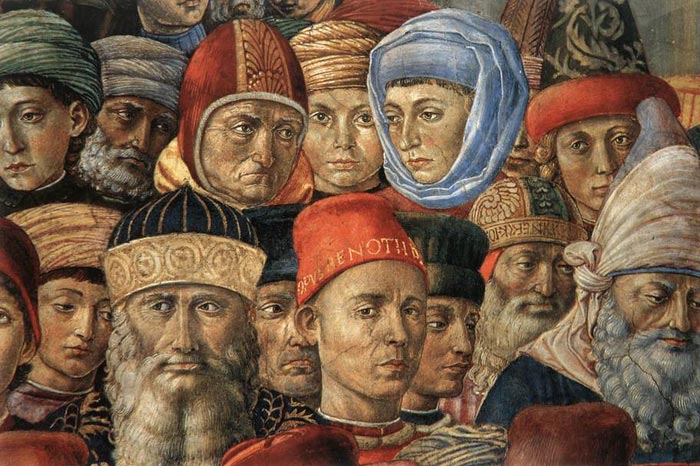 |
|
Benozzo Gozzoli, Procession of the Magi (detail), 1459-60, Palazzo Medici-Riccardi, Firenze |
|
Giorgio Vasari, Lives of the Artists | Benozzo Gozzoli, painter of Florence [1] |
| LIFE OF BENOZZO GOZZOLI, PAINTER OF FLORENCE He who pursues the path of excellence in his labours, although it is, as men say, both stony and full of thorns, finds himself finally at the end of the ascent on a broad plain, with all the blessings that he has desired. And as he looks downwards and sees the difficult and perilous way that he has come, he thanks God for having brought him out safely, and with the greatest contentment he blesses those labours that he has just been finding so burdensome. And so, recompensed for his past sufferings by the gladness of the happy present, he labours without fatigue, in order to demonstrate to all who see him how heat, cold, sweat, hunger, thirst, and all the other discomforts that are endured in the acquiring of excellence, deliver men from poverty, and bring them to that secure and tranquil state in which, with so much contentment, Benozzo Gozzoli enjoyed repose from his labours. This man was a disciple of Fra Giovanni Angelico, by whom he was loved
with good reason; and by all who knew him he was held to be a practised
master, very rich in invention, and very productive in the painting of
animals, perspectives, landscapes, and ornaments. He wrought so many
works in his day that he showed that he cared little for other delights;
and although, in comparison with many who surpassed him in design, he
was not very excellent, yet in this great mass of work he surpassed all
the painters of his age, for in such a multitude of pictures he
succeeded in making some that were good. In his youth he painted a panel
for the altar of the Company of S. Marco in Florence, and, in S. Friano,
a picture of the passing of S. Jerome, which has been spoilt in
restoring the façade of the church along the street. In the Chapel of
the Palace of the Medici he painted the Story of the Magi in fresco. |
|
||
|
QUID SPECTAS VOLUCRES, PISCES, ET MONSTRA FERARUM, Throughout this whole work there are scattered innumerable portraits from the life; but, since we have not knowledge of them all, I will mention only those that I have recognized as important, and those that I know by means of some record. In the scene of the Queen of Sheba going to visit Solomon there is the portrait of Marsilio Ficino among certain prelates, with those of Argiropolo, a very learned Greek, and of Batista Platina, whom he had previously portrayed in Rome; while he himself is on horseback, in the form of an old man shaven and wearing a black cap, in the fold of which there is a white paper, perchance as a sign, or because he intended to write his own name thereon. In the same city of Pisa, for the Nuns of S. Benedetto a Ripa d'Arno, he painted all the stories of the life of that Saint; and in the building of the Company of the Florentines, which then stood where the Monastery of S. Vito now is, he wrought the panel and many other pictures. In the Duomo, behind the chair of the Archbishop, he painted a S. Thomas Aquinas on a little panel in distemper, with an infinite number of learned men disputing over his works, among whom there is a portrait of Pope Sixtus IV, together with a number of Cardinals and many Chiefs and Generals of various Orders. This is the best and most highly finished work that Benozzo ever made. In S. Caterina, a seat of the Preaching Friars in the same city, he executed two panels in distemper, which are known very well by the manner; and he also painted another in the Church of S. Niccola, with two in S. Croce without Pisa. In his youth, Benozzo also painted the altar of S. Bastiano in the Pieve of San Gimignano, opposite to the principal chapel; and in the Hall of the Council there are some figures, partly by his hand, and partly old works restored by him. For the Monks of Monte Oliveto,[Pg 124] in the same territory, he painted a Crucifix and other pictures; but the best work that he made in that place was in the principal chapel of S. Agostino, where he painted stories of S. Augustine in fresco, from his conversion to his death; of the whole of which work I have the design by his hand in my book, together with many drawings of the aforesaid scenes in the Campo Santo of Pisa. In Volterra, likewise, he executed certain works, of which there is no need to make mention. Now, while Benozzo was working in Rome, there was another painter there called Melozzo, who came from Forlì; and many who know no more than this, having found the name of Melozzo written and having compared the dates, have believed that Melozzo stands for Benozzo; but they are mistaken, for the said painter was one who lived at the same time and was a very zealous student of the problems of art, devoting particular diligence and study to the making of foreshortenings, as may be seen in S. Apostolo at Rome, in the tribune of the high-altar, where, in a frieze drawn in perspective, as an ornament for that work, there are some figures picking grapes, with a cask, which show no little of the good. But this is seen more clearly in the Ascension of Jesus Christ, in the midst of a choir of angels who are leading him up to Heaven, wherein the figure of Christ is so well foreshortened that it seems to be piercing the ceiling, and the same is true of the angels, who are circling with various movements through the spacious sky. The Apostles, likewise, who are on the earth below, are so well foreshortened in their various attitudes that the work brought him much praise, as it still does, from the craftsmen, who have learnt much from his labours. He was also a great master of perspective, as is demonstrated by the buildings painted in this work, which he executed at the commission of Cardinal Riario, nephew of Pope Sixtus IV, by whom he was richly rewarded.
|
||
Benozzo Gozzoli, Funeral of St Augustine, 1464-65, fresco, width 440 cm, Apsidal chapel, Sant'Agostino, San Gimignano |
||
 THE DEATH OF S. AUGUSTINE THE DEATH OF S. AUGUSTINE(After the fresco by Benozzo Gozzoli. San Gimigano: S. Agostino) Brogi View larger image But to return to Benozzo; wasted away at last by length of years and by his labours, he went to his true rest, in the city of Pisa, at the age of seventy-eight, while dwelling in a little house that he had bought in Carraia di San Francesco during his long sojourn there. This house he left at his death to his daughter; and, mourned by the whole city, he[Pg 125] was honourably buried in the Campo Santo, with the following epitaph, which is still to be read there: HIC TUMULUS EST BENOTII FLORENTINI, QUI PROXIME HAS PINXIT Benozzo ever lived the well-ordered life of a true Christian, spending all his years in honourable labour. For this and for his good manner and qualities he was long looked upon with favour in that city. The disciples whom he left behind him were Zanobi Macchiavelli, a Florentine, and others of whom there is no need to make further record.[Pg 127] |
||
|
||
|
||
|
||
|
||
|
||
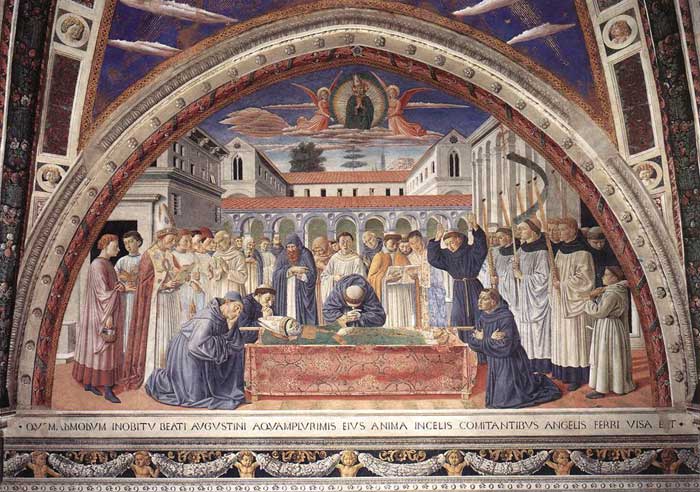
[1] Vasari, Giorgio (b Arezzo, 30 July 1511; d Florence, 27 June 1574). Italian painter, architect, and writer, active mainly in Florence and Rome. In his day he was a leading painter, architect, and artistic impresario, but his activities in these fields have been completely overshadowed by his role as the most important of all artistic biographers. His great book, generally referred to as Lives of the Artists, has earned him the title of the father of art history; it is not only the fundamental source of information on Italian Renaissance art, but also a key document in shaping attitudes about the period for centuries afterwards. (The book was first published in Florence in 1550 as Le vite de' più eccellenti architetti, pittori, et scultori italiani—The Lives of the Most Eminent Italian Architects, Painters, and Sculptors; in 1568 there was a second, much enlarged edition, in which the title is slightly changed, the painters being mentioned first. In addition to biographies, the book contains a lengthy introduction dealing with artists' materials and techniques.) Vasari wrote from a particular aesthetic viewpoint, and his book is not only a collection of biographical information but also a critical history of style. He believed that art is in the first instance imitation of nature and that progress in painting consists in the perfecting of the means of representation. He thought that such representational skills had been taken to high levels in classical antiquity, that art had then passed through a long period of decline in the Middle Ages, and that it had begun to revive in the 14th century in Tuscany (he was heavily biased in favour of his own region). The main theme of the Lives was to set forth this revival—its initiation by Cimabue and Giotto, its steady advance at the hands of such artists as Brunelleschi, Donatello, and Masaccio, and its culmination with Leonardo, Raphael, and above all Michelangelo, whom Vasari idolized and whose biography was the only one of a living artist to appear in the first edition of his book (the second edition adds accounts of several artists then living, including Vasari's autobiography). The idea of artistic ‘progress’ that he promoted subsequently coloured most writing on the period. Given the wide scope and vast size of the book (the second edition has roughly the same wordage as the Bible), it is not surprising that it contains many errors and contentious points (see, for example, Andrea del Castagno and Andrea del Sarto). However, by the standards of the time Vasari was a diligent researcher and he gathered together an enormous amount of invaluable information, which he presented in a lively style, full of memorable anecdotes. Moreover, his qualitative judgements have generally stood the test of time well: the artists and works he most admired are by and large still the ones we most admire today. His book became the model for artistic biographers in other countries, such as van Mander in the Netherlands, Sandrart in Germany, and Palomino in Spain. As a painter, Vasari was one of the most prolific decorators of his period, but he is not now highly regarded, his work representing the most in-bred and affected kind of Mannerism. His best-known achievement in this field is probably the decoration (1546) of the grand salon in the Palazzo della Cancelleria, Rome, with scenes celebrating the life of Pope Paul III, commissioned by his grandson Cardinal Alessandro Farnese. Pressed for quick results by the cardinal, Vasari enlisted a team of assistants and finished the work within 100 days, earning the room its nickname of the Sala dei Cento Giorni. When Michelangelo was told of the remarkable speed with which the work had been accomplished, he is said to have made the withering response ‘E si vede’ (So it appears). As an architect Vasari has a higher reputation; his most important building is the Uffizi in Florence, and he designed and decorated his own house in Arezzo, now a museum dedicated to him. Vasari was the first important collector of drawings, using them partly as research material for his biographies, for the insight they gave into the creative process, and he also played the leading role in establishing Florence's Accademia del Disegno. [IAN CHILVERS. "Vasari, Giorgio." The Oxford Dictionary of Art. 2004. Encyclopedia.com. (June 13, 2011).] |
||||
Art in Tuscany | Art in Tuscany | Giorgio Vasari | Lives of the Most Excellent Painters, Sculptors, and Architects |
||||
|
Art in Tuscany | Benozzo Gozzoli Art in Tuscany | Benozzo Gozzoli, Procession of the Magi in the Palazzo Medici-Riccardi in Florence | The Vintage and Drunkenness of Noah and other frescoes in Pisa | Fresco cycle in the apsidal chapel of Sant'Agostino, San Gimignano Sant'Agostino | Saint Sebastian | |
||||
Holiday accomodation in Tuscany | Podere Santa Pia | Artist and writer's residency
|
||||
Podere Santa Pia |
Podere Santa Pia, garden view, April |
View from Podere Santa Pia
on the coast and Corsica |
||
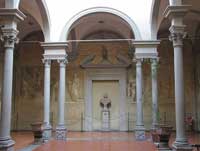 |
||||
Villa Celsa near Florence |
Piazza della Santissima Annunziata in Florence |
Choistro dello Scalzo, Florence |
||
The façade and the bell tower of San Marco in Florence |
Piazza della Santissima Annunziata in Florence |
Florence, Duomo |
||





